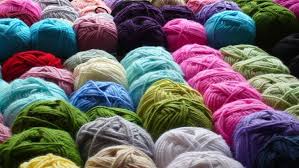Understanding Knitting Yarn and Techniques for Beginners

Types of Yarn in Knitting
1. There are several types of yarn used in knitting. The biggest and bulkiest yarns are called bulky or super-bulky. The lightest and finest yarns are baby (sport) yarns and the very thin thread-like yarns used to make lace. Between the two extremes, there's a yarn that's moderate weight, easy to use and easy to find.
What is it called?b. Worsted or Aran
Fingering Yarn
2. The lightest and thinnest weight of yarn, it is often used for newborn layettes, fancy sweaters, or socks. It's known as "baby" weight or _________ yarn.
d. Fingering
Yarn Packaging
3. Yarn is usually not sold in balls, much to the dismay of kitties everywhere. It's sold as loosely coiled "ropes" or in wrapped oblongs. These units of yarn are known as:
b. Hanks and Skeins
Skeins are machine-created to make life easier for the knitter. They are lightly twisted in such a way that you can easily pull the yarn out from them without twisting it and without much rolling around. Handspun and hand-dyed yarns are usually sold as hanks. Hanks have to be rolled into balls to use.
Types of Fiber Used in Knitting
4. There are three main types of fiber that are used in knitting: synthetic, animal, and plant. Which of the following is a synthetic fiber commonly used to make yarn?
a. Acrylic
The most common synthetic fiber used in home knitting is acrylic/polyester. While this material has its drawbacks, it does have one superior quality -- its washability. While garments or afghans made of natural fiber such as cotton, silk, and wool can be ruined by one accidental plunge into hot soapy water, polyester/acrylic will (like Gloria Gaynor) survive. It's an excellent choice for household items such as potholders and for kid's clothes and toys.
Homemade Knitting Needles
5. Knitting needles can be made at home using dowel rods or chopsticks.
a. True
Craftiness knows no boundaries! Many knitters have successfully created their own needles.
Plant Fibers for Knitting Yarn
6. Name three plant fibers that are used to create knitting yarn.
a. Hemp, cotton, and linen
Hemp, cotton, and linen are three of the most common plant fibers used for knitting yarn. Even banana, soy, and bamboo fibers are now available as yarn. Plant fibers have the advantage of being cruelty-free, and some are sustainable, requiring minimal resources or chemical pesticides or fertilizers. Tomato, locoweed, maple, rattan, wicker, and seagrass are not used for yarn. The other choices are animal, not plant fibers.
Understanding Swatches
7. A small sample of knitting is known as a _____ .
d. Swatch
In order to determine the correct size of a finished item, it's necessary to calculate "gauge" by creating a small sample of knitting known as a swatch. The "gauge" of a project depends on the size of the needles, weight and properties of the yarn, and the tension of the stitches.
Basic Knitting Stitches
8. Beginning knitting projects are created with combinations of two very simple stitches: knit and purl. When only knit stitches are used, the texture that's created looks rugged, ridged, and knobby on both sides and is quite sturdy. This is called the _______ stitch.
d. Garter
A great stitch for beginners, it's easy to do and lends itself to simpler projects.
9. Back to knit and purl. When knit and purl stitches are used in alternating sections in the same row, and the pattern is repeated in the following rows, a special stretchy effect is created that you often find on cuffs and hems.
d. Rib Stitch
One of my first projects was a ribbed scarf. I used alternating bands of brown and variegated autumn colors in a synthetic and wool blend on a round #9 needle. The scarf has long ridges, and it is quite cozy. Very easy and no pattern needed!
10. A project made with this stitch pattern has bumps and ridges on the wrong side of the garment, and a smooth interlocked pattern of "v"s on the right side. Alternating rows of knit and purl stitches create this effect. What is this stitch pattern called?
c. Stockinette Stitch
